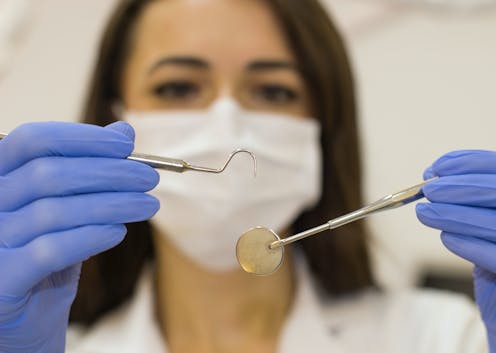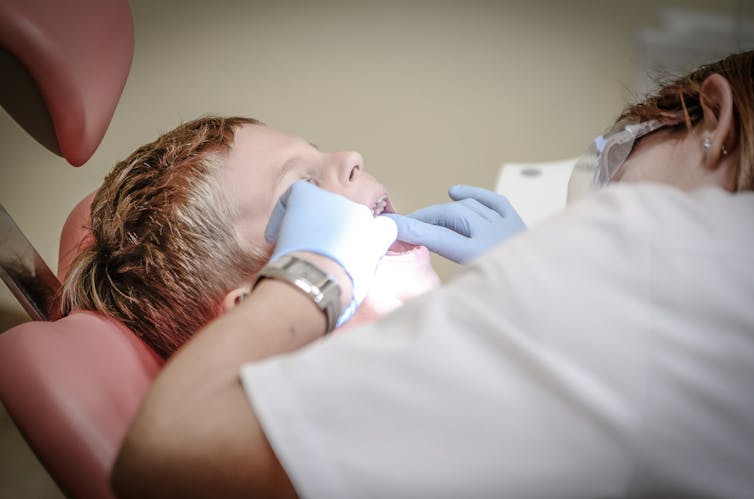
Canadians pride ourselves on our health-care system, especially in comparison with our neighbours to the south. But there are significant gaps in coverage. Nearly one-third of Canadians do not have dental insurance, and that number climbs to 50 per cent for lower-income Canadians. Without dental care, minor issues like cavities can result in serious infections.
Over 10 per cent of Canadians live with pain in their mouth. People visit emergency rooms for care that could be better delivered in a dental office. Canadians lose teeth that could have been saved, which makes it hard to eat nutritiously and can make it more difficult to find work.
Poor oral health can also complicate or contribute to diabetes, heart disease and other chronic diseases.
Why was dental care not included in medicare?
My forthcoming book, The Smile Gap: The History of Oral Health and Social Inequality, explores why dental care was left out of medicare. The 1964 Royal Commission on Health Services, which set the stage for medicare, recommended the establishment of a dental care program for children, using dentists and dental professionals with less training called dental auxiliaries.
The idea was to start with younger children and then expand eligibility to older children. Eventually, adults might be included.

At the time, there was a significant shortage of dentists in Canada and a universal program was not practical. Dentists opposed the idea of publicly funded denticare, especially the use of auxiliaries to treat children.
The idea of using auxiliaries came from New Zealand, where specially trained dental nurses provided treatment in schools. Despite the success of the New Zealand program, dentists did not believe that dental auxiliaries had sufficient training to work without a dentist’s direct supervision.
Dentists thought that more emphasis should be placed on prevention, especially education and water fluoridation. Many had been fighting for water fluoridation in their communities for over a decade. Water fluoridation had been shown to significantly reduce cavities and yet Canadians repeatedly rejected water fluoridation in municipal referendums, leading dentists to conclude that Canadians did not value their oral health.
When the Medical Care Act of 1966 passed, dental care was not included. For the most part, dentists were delighted that they could continue their practices without state interference.
The provinces step in
My book covers the history of dental programs in Canada. Even before medicare, quite a few provinces provided public dental insurance for people on social assistance.
The Ontario dental insurance program, for example, was established in 1958 to provide care for children whose mothers received state support. In 1965, all parents who received family benefits became eligible. Unfortunately, many people who lived in regions without a dentist were unable to access the program.
According to a study by dental public health researcher James Leake, dentists also had problems with the program. They disliked it because it only included basic services and they found it professionally challenging to not provide the best possible service. Dentists also complained that people on social assistance were much more likely to miss appointments than other patients.

Access to care continues to be a problem today. While all provinces provide some dental services to people on social assistance, dentists are often reimbursed at less than their usual fees, making them reluctant to serve these patients.
Dental care for children
In the years after the Second World War, some provinces began providing dental care to all children. The most innovative program was in Saskatchewan, where dental nurses — later called dental therapists — provided care in schools beginning in the mid-1970s. The College of Dental Surgeons opposed the program and it was cancelled in 1987.
In other provinces, children received state-funded care in private dental offices. Although there were significant cutbacks to children’s programs in the late 20th century, Québec, Newfoundland and Labrador, Prince Edward Island and Nova Scotia still have universal dental care programs for children. In the past 15 years, there has been an expansion of targeted programs aimed at low-income children, such as Ontario’s Healthy Smiles
Rise of private dental insurance

In the 1970s, unions began demanding dental insurance. Companies that no longer needed to provide medical benefits to their employees began to offer dental insurance. By 1982, approximately two-thirds of collective agreements included dental benefits and just over one-third of Canadians had private dental insurance. By the mid-90s, over half of all Canadians had private dental insurance.
Even though dental insurance did not cover all services, access to insurance diminished the demand for universal dental insurance.
Gaps in care
This has left some Canadians without dental care. In 2007, journalist Moira Welsh wrote about Jason Jones for the Toronto Star. Jones was a young man, but his teeth had rotted away. In severe pain, he spent his wife’s life savings to remove them.
At the time the article was published, Jones had just two teeth, which the dentists had left in as anchors for dentures. He could only eat soft foods, his appearance was adversely affected and he couldn’t find a job.
Jones’ story had a happy ending. In response to the front-page story, numerous dentists and denturists reached out and dentist Raj Singh provided him with a new smile. Unfortunately, many other Canadians are not so lucky.
The future of denticare
In 2011, the Canadian Centre for Policy Alternatives published the report Putting Our Money Where Our Mouth Is, drawing attention to the need for better dental care. In 2019, the NDP included denticare in its federal election platform. The Liberal government promised to explore universal dental care in its throne speech of December 2019, and in October 2020, the Parliamentary Budget Office costed a program to provide dental care to all Canadians with a household income of under $90,000, similar to what the Non-Insured Health Benefits program provides for Indigenous people.
The NDP made denticare a key demand in its 2021 electoral platform. Most recently, the Liberal government agreed to provide a denticare program, starting with children under 12 and expanding it until everyone with a household income of under $90,000 is covered, with no co-payments for people with a family income of under $70,000.
If the Liberals follow through on their promise, this will reduce the gaps in care and relieve the suffering of many Canadians.
Catherine Carstairs received funding from SSHRC and AMS Health Services for this research.
This article was originally published on The Conversation. Read the original article.







